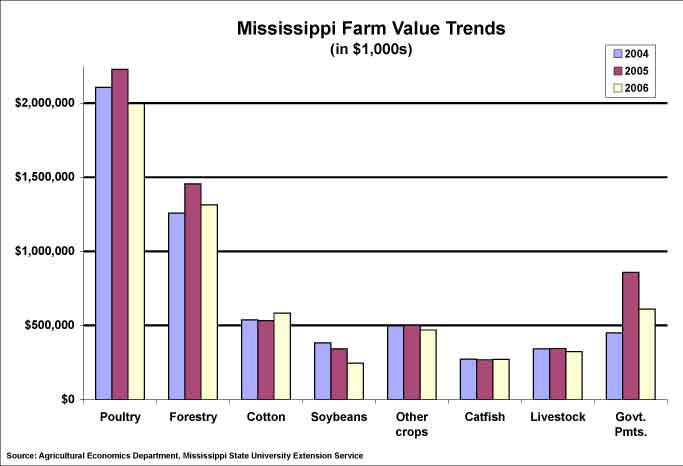Information Possibly Outdated
The information presented on this page was originally released on December 14, 2006. It may not be outdated, but please search our site for more current information. If you plan to quote or reference this information in a publication, please check with the Extension specialist or author before proceeding.
Mississippi's top crops suffer '06 value declines
MISSISSIPPI STATE -- Flooded markets and dry fields were leading causes of an estimated 11 percent decline in Mississippi's farm value of production for 2006.
John Anderson, agricultural economist with Mississippi State University's Extension Service, is predicting a total agricultural value of $5.8 billion, which includes a 29 percent decline in government payments. Mississippi's total farm-gate value in 2005 was $6.5 billion.
|
||||||||||||||||||||||||||||||||||||||||
“Given the level of adversity in production this season, it is not surprising that estimates of the state's value of agricultural production are down,” Anderson said.
Mississippi's strongest commodities are not row crops and even those felt the pinch. Fueled by international fears of avian flu, poultry, the state's No. 1 crop, is expected to decline 10 percent to a total value just under $2 billion.
“We've got clean chickens, but when avian flu concerns started hitting real big, a lot of countries began cutting off all imports of poultry,” said Tim Chamblee, Extension poultry specialist. “The world market was very cautious as that was coming into wide attention.”
At No. 2, forestry still faces a timber market flooded by hurricane-damaged trees. Marc Measells, a research and Extension associate with MSU's Department of Forestry, said forestry is expected to post a value near $1.3 billion, almost 10 percent below 2005's value.
“The decreased value for 2006 is a result of the decline in prices for all hardwood and pulpwood,” Measells said. “As a result of the massive Hurricane Katrina recovery efforts, the standing and delivered timber prices fell significantly across the state in 2006.”
In this land where cotton is king, Mississippi fields suffered from a drought during most of the growing season, and most yields were dependant on sporadic showers and irrigation.
“The irrigated cotton really brought our yield up this year,” said Tom Barber, Extension cotton specialist. “Unfortunately, the effect of low cotton prices and high input costs will probably drive next years acreage to the lowest levels in years.”
Anderson said the state's No. 3 crop should yield a value near $583 million, a $50 million increase over 2005.
“Cotton yields ended up better than expected at 853 pounds per acre, but there is so much cotton available on the market that prices have been down,” he said. “Other row crops, especially corn and soybean, did not perform as well. Their yields were similar to the 2000 levels, which was the last year Mississippi had a significant drought.”
Anderson is estimating the value of soybeans at $246 million, down 28 percent from 2005. Corn's value should be near $94 million, down 7 percent.
“The state's beef and dairy producers suffered from poor pasture conditions and a lack of affordable alternative feedstuffs,” he said. “Although cattle prices remain historically high, the market has declined from 2005, especially at the end of the year. The contrast of the slightly smaller 2006 calf crop and heavy culling in response to limited forage makes it hard to forecast cattle's value.”
Anderson said the dairy industry experienced another difficult year on the heels of Hurricane Katrina's damage.
“With lower milk prices compared to 2005 and production down significantly, the value of dairy in the state is expected to be down by as much as 25 percent from the previous year,” he said.
Hay, the commodity that livestock depend on, was hit hard by the 2006 drought. The economist predicted the value of hay production in Mississippi to be down by about 35 percent from 2005.
The wheat crop was one of the few bright spots for agriculture. Anderson estimated wheat's value at $17 million, up 63 percent.
“Wheat growers increased acreage, posted outstanding yields and enjoyed higher market prices,” he said. “Growers planted 73,000 acres, up by 8,000 acres from the previous year. They set a new yield record of 59 bushels per acre, a 9 bushel increase from 2005.”
2006 marks the first year the U.S. Department of Agriculture is reporting peanut acreage and yields for Mississippi. Acreage in the state increased significantly since the ending of the quota system in 2002. While the 3,000-pounds-per-acre yields were less than the 3,200 pounds they reached in 2005, prices were steady, and acreage expanded to increase the value about 3 percent from $7.6 million to $7.8 million in 2006.
Other crop value estimates and their percentage change from 2005 include: catfish at $273 million, up 2 percent; rice at $118 million, down 7 percent; horticultural crops at $85 million, up 7 percent; sweet potatoes at $74 million, up 19 percent; hogs at $62 million, up 11 percent; and grain sorghum at $2 million, down 36 percent. The total government payments were $610 million, down 29 percent.




